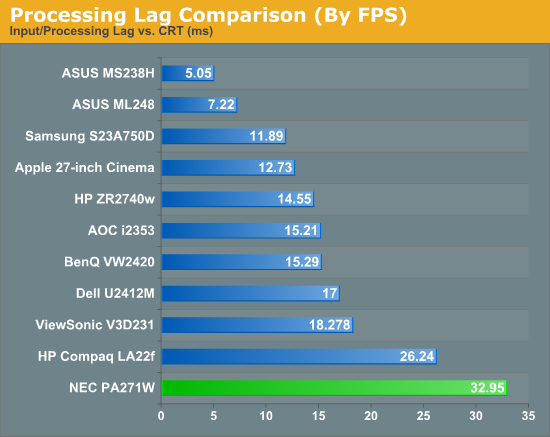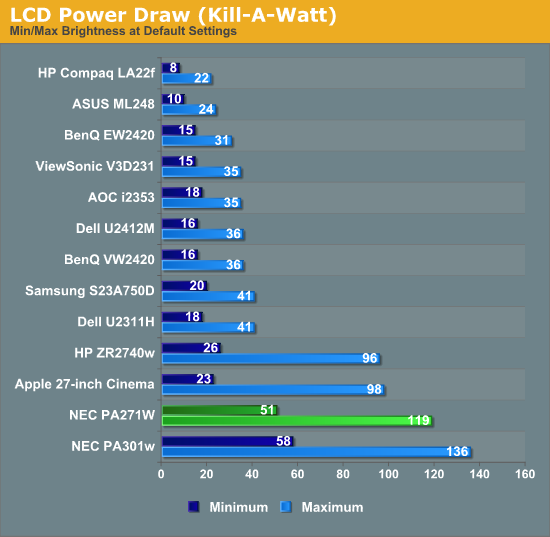NEC PA271W - When Accuracy and Consistency Matter
by Chris Heinonen on May 1, 2012 1:55 PM ESTNEC PA271W - Input Lag and Power Use
The last 27” display I tested, the HP ZR2740w, was a pleasant surprise for gaming as it had a very low lag time despite the IPS panel and high resolution, likely due to the lack of an internal scaler or LUT to add a delay. Since the NEC has a scaler, and the additional custom electronics to provide display uniformity, I wasn’t certain that the NEC would perform as well.

As you can see, the NEC is not going to be a display for a serious gamer, though it really isn’t targeting that market either. The input lag was 20.5 ms, and the pixel response took 24.9 ms to go from blue to yellow to blue, giving us an overall response time of 32.95 ms. The effective (subjective) lag was a little better, but with that high input lag it was still close to 25 ms, which is more than most serious gamers would be interested in. If you want a 27”, 2560x1440 resolution display for gaming the HP is still your best option.
The PA271W has a built in power use monitor showing you how much power you are using with the display, so being efficient is something that it does aim to do. With the backlight set at minimum we used 51 watts, and at maximum we used 119 watts. These were both worse than the HP as well, but since the HP uses an LED lighting system we would expect it to come in behind. Since the LED lighting system provided for a smaller gamut than the NEC's CCFL system produced, and a less uniform screen, I’m certain that had something to do with NEC's decision to stay with the CCFL technology on this panel. Power use wasn’t bad, it just wasn’t exceptional, and any 27” display is going to use far more power than a 24” or smaller one.











69 Comments
View All Comments
B3an - Wednesday, May 2, 2012 - link
2560x1440 instead of 2560x1600 on a high end LCD? Disgraceful. Should be 16:9 ratio!Most people by far will be using this for colour important work, graphic design and so on, not for watching fucking movies. Those extra vertical pixels are important, not to mention better for just about anything else, including viewing web pages.
TegiriNenashi - Wednesday, May 2, 2012 - link
The price for 2560x1600 is insane, even for ebay imports from Korea. No matter how badly ones love tall monitors it is hard to justify spending $1000 vs $350 for 11% increase in screen space. Now that 4K aka QuadHD is on horizon, it's much better strategy to shell small amount and upgrade to 4K later. It is sad that 16:10 and taller AR doesn't seem to be coming back...ggathagan - Wednesday, May 2, 2012 - link
Uh.. you got it backwards, Skippy.2560x1440 *is* 16:9
2560x1600 is 16:10
ozmia - Wednesday, May 2, 2012 - link
I like how this review seems to utterly ignore Dell's U2711? It not only has exceptional colour accuracy straight out of the box in the factory configured modes, but very respectable input lag for a 27" screen, and apart from work, I use it for games and it is fantastic.I don't think you have been particularly non-biased, Chris, and this review has a strong wiff of the favouritism.
The U2711 is probably superior to the HP in most ways bar input lag, yet it does not even get a look in. Very poor indeed.
cheinonen - Thursday, May 3, 2012 - link
Someone else wrote the U2711 review, and I've never had the opportunity to use one myself. Any comparisons I make between the two would only be based on my reading of reviews of the display and not from actual use, which is why I didn't mention it.nurfe - Thursday, May 3, 2012 - link
Did you read the review? The two monitors are in two completely different classes. NEC has a 14 bit lookup-table, hardware calibration, electronically corrects uniformity and colour distribution problems etc. The Dell is a normal ISP office monitor.bishop2020 - Thursday, May 3, 2012 - link
I've read both this review and the earlier U2711 review that Anandtech did and would disagree that they aren't comparable.Uncalibrated DE - Dell 2.24, NEC 7.07.
Calibrated DE - Dell 1.06, NEC 1.1.
AdobeRGB - Dell 96%, NEC 106%.
I'm not saying the NEC isn't a better monitor, I actually wholly agree with you on that point, but to say it's in a different class and not worth comparison seems a tad elitist. Many professionals don't work in AdobeRGB (see http://www.kenrockwell.com/tech/adobe-rgb.htm) and many don't have access to calibration equipment so a lower shipping DE may be something they're more interested in.
As someone who uses a professional 27" monitor daily I have no problem lumping the Dell & HP in with the NEC & Eizos of the world if only for additional data points even if I don't expect them to come out on top (though I make no assumptions that they can't be superior). The requirements you or I might put on a monitor don't necessarily apply to everyone and seeing the comparisons helps people make informed decisions. That said, I respect the author's decision not to include any direct comparison due to lack of first-hand experience in reviewing the Dell.
nurfe - Friday, May 4, 2012 - link
But that's entirely my point. Using a professional monitor without setting it up correctly, and wihout taking full advantage of its features doesn't make any sense. Of course you'll get similar result buying something else, like a Dell, since you're ignoring the premium features you just paid for.Thus, I very much diasgree that finding the common lowest denominator is ground for a comparison.
bjnicholls - Wednesday, November 28, 2012 - link
OMG, Ken Rockwell on displays? Next I'll see him referenced as an expert on toaster ovens.A professional who isn't provided or can't afford calibration tools isn't a very valuable or valued professional. You need wide gamut if you design for print. But even more, you need a display that has color and luminance uniformity so you can view and work with reasonable precision on large images and designs.
I just returned a Dell U3011 display because it had an obvious color shift across a third of the display. And looking at uniform background colors, it had really poor luminance consistency. At least compared to my aging NEC 3090 display.
I was hoping that a Dell would be "good enough" for design and image editing, but I'm back to finding the best buys I can get on NEC displays. The difference is not subtle and if your work requires consistent, accurate color you should at least aspire to a display designed to deliver the performance you need.
It's interesting that people who spend thousands of dollars on cameras and lenses with excellent image capture capability will cheap out on the one most critical tool they need to view and work with those images. It's like having a professional audio studio but listening to the sound via a cheap sound system.
xKeGSx - Wednesday, May 2, 2012 - link
Any word on the VA278q that was announced at CES 2012?